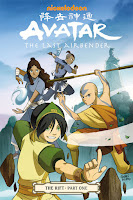Writer: Gene Luen Yang, Michael Dante DiMartino, Bryan Konietzko
Artist: Gurihiru
Letterer: Michael Heisler
Avatar: The Last Airbender created by Michael Dante DiMartino and Bryan Konietzko
The Rift is the third Avatar story after The Promise and The Search told by Gene Yang and Gurihiru. So it's become clear that this creative team's working within a very rigid framework. Contort the narrative to fit the three part structure. Start slow. Pad the story with subplots and evenly spaced revelations. Finish with a big fight that pushes the combatants into an understanding of sorts. The results so far have been somewhat underwhelming. The comics are burdened with an unfortunate sensation that their plots are warped to fit the page count and are a tad emotionally manipulative. With that said, The Rift is still their best effort yet. This is primarily because of the presence of fan favourite Toph Beifong to liven up the proceedings.
One of the biggest shortcomings with the graphic novel series is the generally flat character development of its main cast. These once rebellious teens have since settled into boring adult roles after the conclusion of the animated series. In The Promise, both Aang and Zuko are surprisingly bereft of any agency as they're driven into a conflict dictated by their responsibilities to opposing factions and the expectations hoisted upon them by their respective followers. Neither have since regained the irrepressible energy that characterized their televised incarnations and drove the entire series. the independent Katara has been reduced to supportive girlfriend with no voice of her own. And her quick witted brother Sokka has been largely stuck in odious comic relief mode.
Only Toph escapes this fate by striking out on her own. She's first shown establishing her metalbending academy in The Promise, and the fruits of her labour are revealed in The Rift. She's the only significant character who's comfortable contradicting Aang, and the primary conflict for this arc is made more personal because it arises from the differences between the two. Aang's the spiritualist always striving to make everyone happy while Toph's the materialist willing to buck tradition.
What sets this up is Aang's attempt to revive an important Air Nomad festival. He unexpectedly discovers that the ritual's once sacred site is now the address of a rapidly expanding factory town. Aang then detects the presence of a disapproving spirit and moves to shut the factory down. But he's stymied by Toph. While Aang quickly blames the factory for the area's spiritual pollution, Toph sees little point in continuing a custom that apparently serves no purpose while noting the real socio-economic benefits of the factory to the local community. Their opposing points of view puts them at odds with each other, giving the story an emotional edge missing in the similarly themed The Promise and generates a tone of moral ambiguity that can't be neatly resolved by either side.
At the same time, the story is one huge nod to continuity. The Last Airbender was about Aang fighting a burgeoning industrial state waging a war of conquest on the entire world, while Legend of Korra is about Aang's successor working within a multiethnic society caught up in the midst of intense industrialization. The Rift is a bridge meant to reconcile these two settings and explains how the Earth Kingdom and Water Tribes became enthusiastic supporters of technological progress. There's an evil Fire Nation capitalist who serves as the story's principal villain, but he feels very much like a throwback to an earlier era. Who cares about him when the story involves young metalbenders duking it out with one hundred foot tall spirits?
That shock of the new is the story's most notable feature. Gurihiru has done a fine job so far in tweaking the ATLA universe. But now they get to introduce a few modern elements. When the cast first sets their eyes on the factory, it just feels wrong standing there. There's nothing extraordinary about it from the outside for anyone who lives in the real world. It's just another grimy building. It's just that in this fantastical setting it feels like a desecration. A pox on the natural beauty of the landscape. Something only an abusive Fire Lord could love.
But as Aang is given a tour of the facilities by an enthusiastic (and way too oblivious for his own good) chief engineer, he witnesses something he's been striving so hard to achieve all this time now being independently realized: balance, harmony. People from the surviving three nations coming together and working towards a common goal on the factory floor. More so than when he first visited the town of Yu Dao back in the first comic, Aang must learn a few bittersweet lessons. Change is inevitable. People adapt. And things don't always work out the way you intended it.






